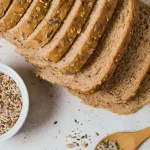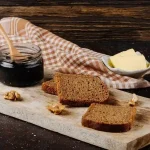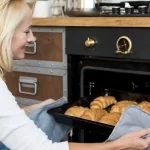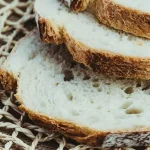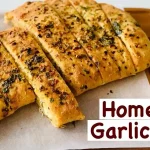Quick Summary
The main difference between Leavened vs Unleavened Bread is that leavened bread contains yeast or rising agents that create gas bubbles, making it fluffy and airy, while unleavened bread has no rising agents and remains flat and dense. Leavened bread uses yeast or baking soda to ferment and puff up during baking, taking 1-3 hours or more. Unleavened bread is made simply from flour, water, and salt, requiring no rising time. Leavened bread has a light, soft texture perfect for sandwiches, while unleavened bread is chewier and ideal for wraps and flatbreads like tortillas and naan.
Introduction: Understanding These Two Bread Types
Have you ever wondered why some bread is soft and fluffy while other bread is flat and chewy? The answer lies in one simple thing: whether the bread uses a leavening agent or not. This basic choice completely changes how bread looks, tastes, and feels when you eat it.
I first learned this lesson when I tried making matzo bread at home. I was expecting it to puff up like my regular white bread, but it stayed completely flat. That’s when I realized that not all bread uses yeast. This discovery opened my eyes to a whole different world of bread baking, from Italian ciabatta to Indian naan to traditional tortillas.
The difference between leavened and unleavened bread is simple but important to understand. Whether you are a home baker, someone with dietary restrictions, or just curious about food, knowing this difference will help you choose the right bread for your meals and understand different cultures and their food traditions.
Related Guide: Easy Brookie Caramel Slice Recipe
What Is Leavened Bread?
Leavened bread is bread that rises and becomes puffy because of a leavening agent. The most common leavening agent is yeast, a tiny living organism that eats the flour in the dough and creates gas bubbles. As these gas bubbles form inside the dough, they make the bread expand and puff up before and during baking.
How Leavened Bread Works
The process is quite simple:
- Yeast is added to dough with flour, water, salt, and sometimes sugar or oil.
- The yeast eats the carbohydrates in the flour and creates carbon dioxide gas.
- Gas bubbles form inside the dough, making it rise and expand.
- The bread becomes light and airy with a soft, pillowy texture.
- During baking, the heat kills the yeast, but the gas bubbles stay, keeping the bread fluffy.
Some leavened breads use other rising agents besides yeast, like baking soda or baking powder. These create gas very quickly, which is why quick breads like banana bread and soda bread can be made in much less time.
Common Examples of Leavened Bread
Here are breads you probably eat every day that use leavening agents:
- White bread and whole wheat bread – The soft bread you buy at the grocery store
- Pizza dough – Uses yeast to create a fluffy, chewy crust
- Bagels – Boiled and then baked with yeast
- Baguettes – A crispy French bread made with yeast
- Sourdough – Uses natural wild yeast and bacteria for a tangy flavor
- Ciabatta – An Italian bread with lots of big air holes
- Focaccia – A flat bread that is still leavened and soft
- Banana bread and quick breads – Use baking soda or baking powder instead of yeast
What Is Unleavened Bread?
Unleavened bread is bread made without any yeast or rising agents. It’s the oldest form of bread, dating back thousands of years. These breads are flat, denser, and chewier than their leavened cousins. Unleavened bread is simple: just flour, water, salt, and sometimes fat like oil or butter.
How Unleavened Bread Is Made
The process is super straightforward:
- Mix flour and water (and salt) to make a dough.
- Knead the dough to develop texture.
- Cook on a hot griddle or skillet until the dough puffs slightly from steam (but doesn’t rise like yeast bread).
- The bread stays mostly flat because there is no yeast or gas-creating agent.
Common Examples of Unleavened Bread
Unleavened breads are popular in many cultures around the world:
- Tortillas – Soft flatbread used in Mexican cooking
- Roti and chapati – Traditional Indian flatbreads
- Naan – Wait! Some naan has baking soda or yogurt that makes it puff a little, but traditional naan does not use commercial yeast
- Matzo (matzah) – Eaten during Jewish Passover, very crispy and flat
- Pita bread – Actually, many pita breads use yeast, but thinner versions are unleavened
- Flatbread – Various types used around the world
- Cracker bread – Very thin and crispy
Key Differences Between Leavened and Unleavened Bread
| Feature | Leavened Bread | Unleavened Bread |
|---|---|---|
| Yeast or Rising Agent | Yes (yeast, baking soda, or baking powder) | No rising agents |
| Rising Time | Takes 1-3 hours or more | No rising time needed |
| Texture | Light, fluffy, airy | Dense, flat, chewy |
| Height/Puffiness | Puffs up during baking | Stays mostly flat |
| Density | Less dense | More dense |
| Shelf Life | Usually shorter | Usually longer |
| Ease of Making | Takes more time | Quicker to prepare |
| Flavor | Can have complex flavor from fermentation | Simple, plain flavor |
| Common Uses | Sandwiches, toast, rolls | Wraps, side dishes, cultural foods |
| Cultural Importance | Modern baking worldwide | Traditional breads in many cultures |
Why Does the Rising Process Matter?
The rising process in leavened bread does more than just make bread puff up. Fermentation (the process where yeast works) also changes the flavor and nutrition of the bread.
What Fermentation Does:
- Creates flavor – The yeast creates acids that give bread a more complex, interesting taste
- Makes bread easier to digest – The fermentation breaks down some of the tough parts of wheat
- Develops texture – Long fermentation helps create those beautiful air holes (called crumb)
- Extends shelf life – Fermented bread stays fresh longer than quick breads
- Can reduce gluten – Some people with slight gluten sensitivity find sourdough easier to digest
Unleavened bread, on the other hand, skips all this and stays simple. This is actually why unleavened bread is used in some religious ceremonies—its simplicity has meaning. For example, matzo bread is eaten during Passover as a symbol of simple, humble food.
Leavening Agents: What Makes Bread Rise?
If you want to make leavened bread, you need to understand the different leavening agents:
1. Commercial Yeast
Active dry yeast and instant yeast are the most common types for home baking. These are dried versions of yeast that you can buy in packets. They need warmth, moisture, sugar, and flour to work.
2. Sourdough Starter
Wild yeast and bacteria naturally live on wheat and in the environment. When you mix flour and water and let it sit, these microbes start to grow. This creates a “starter” that you can use to leaven bread. Sourdough has a tangy flavor because of the acids created during fermentation.
3. Baking Soda
Baking soda (also called sodium bicarbonate) creates gas immediately when it mixes with an acid like buttermilk or lemon juice. This is used for quick breads like soda bread and banana bread.
4. Baking Powder
Baking powder contains baking soda plus an acid already mixed in. It creates gas when wet and when heated. Many quick breads use baking powder.
5. Whipped Egg Whites and Steam
Some breads and baked goods use whipped egg whites (which trap air bubbles) or rely on steam from the oven to puff up. This is less common for everyday breads but is used in some specialty items.
Nutritional Differences
Leavened bread made with yeast often has some nutritional advantages:
- Lower phytic acid – Fermentation reduces phytic acid, which means your body can absorb minerals like iron and zinc better
- More B vitamins – Yeast adds some B vitamins to bread
- Easier digestion – The long fermentation breaks down gluten and starches, making it easier to digest
Unleavened bread is typically:
- Higher in phytic acid – This can block mineral absorption
- Denser – Contains more fiber by weight because there are no air holes
- Simpler – Just flour, water, and salt in many cases
That said, both types are bread, and both have nutritional value. Whole wheat unleavened bread still has good nutrition. The difference is not huge.
When to Use Each Type
Use Leavened Bread When:
- You want a soft, fluffy texture for sandwiches
- You’re making toast or want a bread that stays fresh longer
- You enjoy complex flavors from fermentation
- You want bread that is easier to digest for some people
- You’re looking for everyday bread for most meals
Use Unleavened Bread When:
- You need bread quickly without rising time
- You’re following a religious tradition (like Passover or certain church services)
- You want to wrap or roll bread (tortillas, wraps)
- You prefer a denser, chewier texture
- You’re making flatbreads for specific cuisines
- You have time restrictions and can’t wait hours for rising
Recipe Card
Homemade Leavened Whole Wheat Bread
This is a simple, delicious recipe for leavened bread that you can make at home.
Prep Time: 15 minutes
Rising Time: 2-3 hours
Baking Time: 30-35 minutes
Total Time: 3-4 hours
Servings: 1 loaf (about 12 slices)
Ingredients:
- 3 cups whole wheat flour (or 2 cups whole wheat + 1 cup all-purpose)
- 1¼ cups warm water (about 110°F or 43°C)
- 2 teaspoons salt
- 1½ teaspoons instant yeast
- 1 tablespoon honey or sugar (optional, helps yeast activate)
- 1 tablespoon olive oil (optional, makes crust softer)
Instructions:
- Mix the dough – Pour warm water into a large bowl. Add yeast and let it sit for 1-2 minutes (you should see it start to foam). Add flour, salt, honey, and oil.
- Knead – Mix everything together until it forms a shaggy dough. Knead by hand for 8-10 minutes until the dough feels smooth and slightly sticky. You can also use a stand mixer with a dough hook.
- First rise – Place the dough in a lightly oiled bowl, cover with a damp towel, and let it rise in a warm place for 1-2 hours until it doubles in size.
- Shape – Turn the dough out onto a clean surface. Shape it into a round ball or place it in a greased loaf pan.
- Second rise – Cover and let it rise again for 45 minutes to 1 hour until it looks puffy.
- Bake – Preheat your oven to 425°F (220°C). Bake for 30-35 minutes until the crust is golden brown and the bread sounds hollow when you tap the bottom.
- Cool – Remove from the oven and let cool on a wire rack for at least 15 minutes before slicing.
Chef Tips & Notes:
- Water temperature matters – If your water is too hot (above 120°F), it will kill the yeast. If it’s too cold, the yeast works very slowly.
- Warm place to rise – A kitchen counter away from cold windows works fine, or place the bowl inside an oven with just the light on for extra warmth.
- You can skip the sugar and oil – These are optional. The bread will still rise without them, though the crust might be crispier without the oil.
- Whole wheat bread rises more slowly – Whole wheat flour is denser than white flour, so expect longer rising times.
- Storage – Keep finished bread in a paper bag (not plastic) at room temperature for 2-3 days. Slice and freeze extra pieces for up to 2 months.
- Reheating – Wrap slices in foil and warm in a 350°F oven for 10 minutes, or toast them.
Nutrition Information (Per Slice):
- Calories: 110
- Protein: 4g
- Carbohydrates: 21g
- Fiber: 3g
- Fat: 1g
- Sodium: 290mg
Note: Nutrition is approximate based on standard whole wheat flour. Actual values may vary.
Conclusion: Choosing the Right Bread for You
Now that you understand the difference between leavened and unleavened bread, you can make smart choices about what you eat and even try baking your own. Leavened bread with yeast is soft, fluffy, and perfect for sandwiches and everyday eating. Unleavened bread is flat, dense, and perfect for wraps, cultural dishes, and quick meals.
Both types of bread have been around for thousands of years, and both have their place in cooking. Whether you’re baking homemade whole wheat bread or buying tortillas for dinner, you now know exactly what’s happening inside that dough.
Frequently Asked Questions about Leavened vs Unleavened Bread
What Does “Leavened” Really Mean?
“Leavened” simply means the bread has been made to rise using an agent that creates gas bubbles. The word comes from “leaven,” which is anything (usually yeast) that makes dough rise and puff up. So leavened bread is risen bread.
Can I Make Unleavened Bread in the Oven?
Yes! Most unleavened breads are cooked on a stovetop in a skillet or griddle, but you can also bake them in the oven at 400-425°F for 8-12 minutes. The result will be slightly different (more crispy, less chewy), but it works.
How Long Does Leavened Bread Last?
Leavened bread made with yeast usually lasts 3-5 days at room temperature in a paper bag. Keep it in a cool, dry place—not in the fridge, which actually makes bread go stale faster. You can freeze leavened bread for 2-3 months. Unleavened bread like tortillas usually lasts 3-7 days and also freezes well.
Is Sourdough Leavened or Unleavened?
Sourdough is a leavened bread. It uses wild yeast and bacteria instead of commercial yeast, but it still ferments and rises. The rising process takes longer than commercial yeast (sometimes 12-18 hours), but it’s definitely a leavened bread.
What’s the Difference Between Yeast and Baking Soda?
Yeast is a living organism that eats flour and creates gas slowly over hours. Baking soda is a chemical that creates gas instantly when mixed with an acid. Yeast takes time but creates more complex flavors. Baking soda is fast but mainly just makes bread puff up.
Can People with Gluten Sensitivity Eat Both Types?
Both leavened and unleavened bread can be made with gluten-free flour. However, some people with mild gluten sensitivity find sourdough (a leavened bread) easier to digest because fermentation breaks down some gluten. Unleavened gluten-free bread might be harder to digest for these people. Always check with a doctor or dietitian about your specific situation.
Does Unleavened Bread Have Any Health Advantages?
Unleavened bread is not inherently healthier or less healthy than leavened bread. Both can be nutritious. Unleavened bread is slightly denser, so it has more fiber per slice, but leavened bread (especially sourdough) has benefits from fermentation. Choose based on taste preference and cultural traditions rather than health alone.
The next time you see bread rising in the oven or a flat tortilla cooking on a griddle, you’ll understand what makes each one special. Happy baking!




